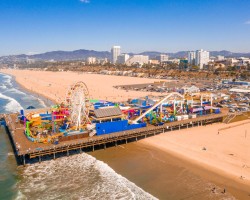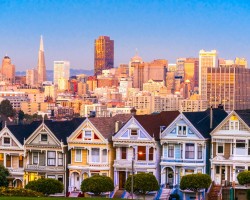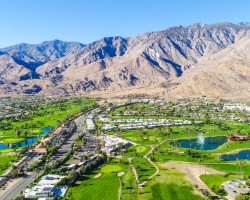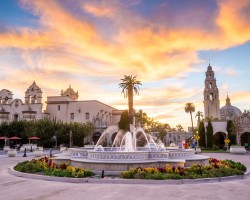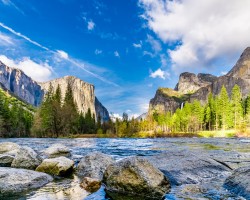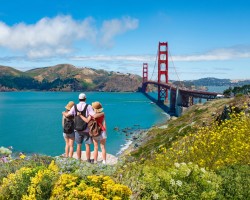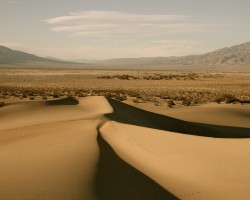Best time to go to California for a perfect weather and where to go?
When is the best time to go to California?
The best time to visit California extends from March to November. Indeed, the diversity of tourist attractions and activities that can be practiced there makes this destination one of the most popular in the United States, almost all year round.
The choice of your travel dates will mainly depend on what you want to do and see on the spot:
- To explore the national parks of the West, such as the famous Yosemite or Sequoia, it is ideal to go between May and September, when snow is not present on the mountains and temperatures are perfect for hiking or other outdoor activities.
- To visit Death Valley, go in spring or autumn. During the summer season, temperatures are extremely hot, even dangerous, while in winter, biting cold and even snow are part of the landscape.
- For a sunny holiday along the 1300 km of the Californian coast, it is best to go in summer, between June and September. You can fully enjoy the beach and, why not, try surfing, a very popular activity in the region!
- For a city trip in one of the mythical Californian cities, a trip is possible all year round, especially in Los Angeles, San Diego. However, July and August experience a peak in attendance that can deter many, while in winter, the northern part of California, around San Francisco, is quite cool and humid. Therefore, prefer spring and autumn for an unforgettable stay exploring Hollywood or the Golden Gate Bridge!
- To attend the grape harvest and go on a wine trip, autumn is ideal. The San Francisco region and Napa Valley are renowned for their magical colors.
- When to go to California to see whales? Two periods are suitable: between June and October to observe blue whales and from December to May to admire gray whales. Apart from a boat trip, the best spots to see them from the mainland are in Santa Monica, Monterey, Mendocino, or Santa Barbara.
- For skiing or other winter sports in the Sierra Nevada resorts, go to California between November and March. Some resorts even stay open until April, depending on weather conditions. Although very popular, the Christmas period there is truly magical.
Annual weather in California
For information about the climate and the weather city by city in California for a specific month, click on the corresponding line below:
| Month | Our opinion | View Details | |||
|---|---|---|---|---|---|
| January | -7°C to 21°C | tolerable weather* | |||
| February | -8°C to 21°C | tolerable weather* | |||
| March | -5°C to 24°C | good weather* | |||
| April | -0°C to 28°C | good weather* | |||
| May | 4°C to 32°C | perfect weather* | |||
| June | 11°C to 39°C | perfect weather* | |||
| July | 15°C to 41°C | perfect weather* | |||
| August | 14°C to 41°C | perfect weather* | |||
| September | 9°C to 37°C | perfect weather* | |||
| October | 2°C to 30°C | perfect weather* | |||
| November | -3°C to 24°C | good weather* | |||
| December | -8°C to 20°C | tolerable weather* |
Best time to travel to California by cities
Climate and Weather in California
If the region is so attractive, it is because of the diversity of its relief and landscapes. From the peaceful coasts to deserts where the altitude can be lower than sea level, passing through the Sierra Nevada with Mount Whitney reaching 4421 m, all of this greatly influences the weather in California.
In general, it is always cooler at higher altitudes than along the coast, and deserts experience very large temperature variations between seasons, as well as between day and night.
Thus, the climate of California varies from one locality to another and from one latitude to another. Here are the main trends:
- A predominantly Mediterranean and temperate summer climate covers 74% of California's territory. It can be found, for example, in Los Angeles, San Francisco, or Sacramento.
- A Mediterranean and hot summer climate is more prevalent as you move inland. This is the climate that prevails in Palm Springs.
- Elsewhere, the climate is occasionally semi-arid or arid depending on the area. For example, there is a dry and cold steppe climate in San Diego, while it is more dry and hot in the Anza-Borrego Desert State Park. In Death Valley, there is a cold and dry desert climate, but make no mistake, summers there are scorching!
It is also worth noting that the temperature of the water in the Pacific Ocean varies greatly depending on where you are on the coast. While it can easily reach 22°C in Los Angeles and San Diego in the heart of summer, it rarely exceeds 16°C on the San Francisco side during the same period.

Climate of the Northern California Coast
The northern coast stretches from Big Sur, just below San Francisco, to the Oregon border.
The climate conditions of this part of California are characterized by mild winter temperatures and spring-like summer highs.
The small temperature difference between seasons makes the climate rather pleasant, especially as one can enjoy good sunshine from April to September. In winter, temperatures range between 15 and 17°C, while in summer, it is rare for the thermometer to exceed 24°C. Regardless of the season, it is very cool at night. Expect average lows around 10°C from November to April and around 15°C the rest of the year.
However, some days see the rise of fog, which can persist for a good part of the day, especially during the summer season from June to September. Rain, on the other hand, is frequent in winter, from mid-December to February.
Climate of the Southern California Coast
From Big Sur to Mexico, the climate of the southern Californian coast translates into mild winters, hot summers, and very pleasant shoulder seasons.
From December to March, the average daytime temperature is 20°C. In April, May, and November, highs are around 23-24°C. The mercury really rises between June and October, with temperatures ranging between 26 and 30°C, with August and September being the hottest months of the year.
In terms of precipitation, it is almost non-existent from April to November, and slightly more pronounced from December to March with about 3 rainy days per month. January is the wettest month, but monthly rainfall rarely exceeds 100 mm.
Climate of the California Inland
As soon as one moves away from the coasts and the impact of the ocean, the climate conditions are strongly influenced by the surrounding relief.
For example, in Palm Springs, the climate is hot, dry, and almost always sunny. It ranges from 30 to 35°C from June to September, around 20°C in the shoulder seasons, and an average of 17°C in winter, from December to March.
From June to September, temperatures can become unbearably hot, with heat peaks in Death Valley like in Furnace Creek The climate in the Sierra Nevada is characterized by significant temperature variations between seasons, even during the same day. The seasons are very distinct there:Climate of the Mountains in California
Temperatures and rainfall in California
On these 3 graphs, we present the evolution of temperatures of California and month-by-month rainfall for the cities of Los Angeles , San Francisco, Palm Springs, San Diego and Yosemite National Park, as well as the month-by-month sea temperature for coastal cities.
Peak visitor numbers and tourist seasons in California
Find out when California has its high tourist season (the period when the influx of tourists is highest) and off-peak tourist season using our data and figures.
Tourist seasons in California
The months with low numbers of tourists are: January, February, March, April, May, October, November and December. The number of visitors to California is high in: June, July, August and September.
- Very low season in California: January, February, March and November.
- Low season in California: April, May, October and December.
- High season in California: June and September.
- Peak season in California: July and August.
Figure: Visitor index for California month by month
Average price for flights to California
A return flight between Sydney and Los Angeles is generally cheaper if you go in february ($ 1158 on average): this is the best time for travellers on a tight budget. In contrast, you may end up paying $ 589 more for your airline ticket to Los Angeles if you go in december.
Find the best price for your flight Flight prices to California
Where to go in California?
This table allows you to see the maximum temperature for each city and our opinion on the weather month by month (see colour legend below the table).
| Cities | jan. | feb. | mar. | apr. | may | jun. | jul. | aug. | sep. | oct. | nov. | dec. |
| Los Angeles | 20°C | 20°C | 21°C | 23°C | 24°C | 26°C | 29°C | 30°C | 30°C | 27°C | 24°C | 19°C |
| San Francisco | 15°C | 16°C | 17°C | 19°C | 20°C | 22°C | 24°C | 24°C | 25°C | 23°C | 18°C | 15°C |
| Palm Springs | 17°C | 18°C | 20°C | 24°C | 27°C | 34°C | 36°C | 35°C | 33°C | 27°C | 21°C | 16°C |
| San Diego | 20°C | 19°C | 19°C | 20°C | 21°C | 23°C | 25°C | 26°C | 27°C | 25°C | 22°C | 19°C |
| Yosemite National Park | 4°C | 3°C | 4°C | 8°C | 12°C | 20°C | 24°C | 24°C | 21°C | 14°C | 8°C | 3°C |
| Angeles National Forest | 16°C | 15°C | 17°C | 20°C | 22°C | 27°C | 30°C | 30°C | 29°C | 24°C | 20°C | 15°C |
| Anza-Borrego Desert State Park | 19°C | 19°C | 22°C | 26°C | 29°C | 35°C | 37°C | 37°C | 35°C | 29°C | 23°C | 17°C |
| Big Sur | 15°C | 15°C | 15°C | 16°C | 17°C | 19°C | 21°C | 21°C | 22°C | 20°C | 18°C | 15°C |
| Cambria | 17°C | 17°C | 18°C | 19°C | 21°C | 23°C | 24°C | 25°C | 25°C | 23°C | 20°C | 16°C |
| Carmel-by-the-Sea | 15°C | 15°C | 15°C | 16°C | 17°C | 19°C | 21°C | 21°C | 22°C | 20°C | 18°C | 15°C |
| Channel Islands National Park | 17°C | 16°C | 16°C | 17°C | 17°C | 18°C | 20°C | 21°C | 22°C | 21°C | 19°C | 17°C |
| Chico | 15°C | 15°C | 17°C | 21°C | 26°C | 32°C | 37°C | 36°C | 33°C | 26°C | 18°C | 13°C |
| Cleveland National Forest | 19°C | 19°C | 20°C | 22°C | 23°C | 27°C | 30°C | 31°C | 30°C | 26°C | 22°C | 18°C |
| Crescent City | 11°C | 11°C | 12°C | 14°C | 16°C | 18°C | 20°C | 21°C | 20°C | 17°C | 13°C | 11°C |
| Death Valley National Park | 17°C | 19°C | 23°C | 27°C | 32°C | 39°C | 41°C | 41°C | 37°C | 29°C | 22°C | 16°C |
| Encinitas | 19°C | 18°C | 19°C | 20°C | 20°C | 22°C | 25°C | 26°C | 26°C | 24°C | 22°C | 18°C |
| Eureka | 13°C | 13°C | 13°C | 15°C | 16°C | 19°C | 21°C | 21°C | 21°C | 19°C | 15°C | 13°C |
| Furnace Creek | 17°C | 19°C | 23°C | 27°C | 32°C | 39°C | 41°C | 41°C | 37°C | 29°C | 22°C | 16°C |
| Gaviota | 18°C | 18°C | 19°C | 21°C | 22°C | 25°C | 27°C | 27°C | 27°C | 25°C | 21°C | 18°C |
| Golden Gate National Recreation Area | 15°C | 15°C | 16°C | 17°C | 18°C | 20°C | 21°C | 22°C | 23°C | 21°C | 18°C | 14°C |
Legend:
perfect weather
good weather
tolerable weather
bad weather
very bad weather
About California
What can I do in California?
Beaches / swimming
Nature and countryside
Culture and heritage
Sports
Family travel
Crafts / shopping
Gastronomy
Nightlife
Is this weather information for California reliable?
Climate data for California has been gathered every day since January 2009. The analysis of these meteorological data for California allows us to determine the average for each month in Los Angeles , San Francisco, Palm Springs, San Diego, Yosemite National Park, Angeles National Forest, Anza-Borrego Desert State Park, Big Sur, and 81 other cities.
So yes: this data is reliable except in cases of temporary climate disruption in the region.
